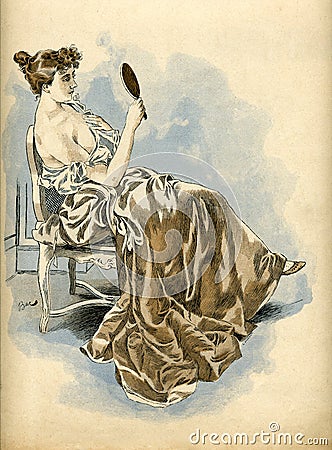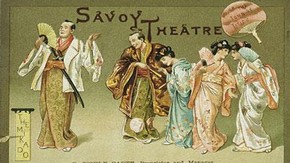Gabriela Hernandez opens the section by saying Queen Victoria's rule helped influence popular culture to accept beauty as a natural commodity, therefore only powders, toilette waters, and face creams were acceptable, not makeup. Their toiletry tables still held a variety of brushes, nail buffers, hairpins, combs, and mirrors.

The practice of bathing, grooming, and sanitation had now become a conscious effort. Sanitation laws were passed, public toilets regulated, and bathtubs were installed in the homes of those who could afford it. However, body odor was still not considered offensive, despite the rise in scented toilette waters, perfumes, and scented pashminas imported from India.
The ideal beauty was pale with round and youthful features, pinked lips and cheeks, and not a trace of makeup. That did not stop women from dedicating time to improving their appearances, those in the wealthier classes were expected to spend time beautifying themselves, and instructional pamphlets were published to help women with beauty tips.
Many books were dedicated to beauty routines that instructed women on how to attack time and nature. Two full hours per day were recommended to carry out a proper beauty regimen. Women chose to endure their timely grooming practices so as not to appear plain and unattractive. (Hernandez, 42)
Use of cosmetics by men were still considered a taboo. Shaving soap, cologne, and pomade were acceptable, but excessive use often connected a man to homosexual stereotypes and he was labeled a 'Dandy' or a 'Fop'. (i.e. Oscar Wilde)

Hernandez mentions The Great Exhibition of 1851 in London, where there were lavish displays of cosmetics and toilette items for purchase. Therefore, cosmetics were beginning to be generally accepted and demanded by the public. The use of cosmetics and perfumes were brought to America with immigration, along with the instructional books that were published and used in Europe.

When Napoleon became Emperor of France, he lifted the restriction on cosmetics and perfumes. His first wife, Josephine, was a huge fan of rouge, applied it in large quantities, and often spent vast amounts of money on it. Napoleon himself was partial to cologne and scented soap.
At the time rouge had become available in cream and liquid form, but metallic elements of lead in it caused it to damage skin. Versions of early lipstick became available by the end of the 19th century.
In the 1890's, bright red lip salves similar to current lipsticks used today, were applied. Before then, lips were touched with face ream or rouge. (44)
Pomades, creams, paints, and fragrant waters had all become available beyond the wealthy class and could be purchased by people of many economic backgrounds. Popular advertising with the use of celebrity images, fetching catch phrases and designs, and promise of the exotic all helped push commercial sales. When international trade with Japan opened to Europe, images of the Japan heavily influenced popular culture, the same way the mysterious allure of the Middle East had. This would also occur again when the discovery of King Tut's Tomb would influence years of fashion, home decor, and makeup trends in the 1920's.

Works cited:
Hernandez, Gabriela. Classic Beauty, The History Of Makeup. Atglen, PA: Schiffer Publishing Ltd, 2013. Print.
No comments:
Post a Comment